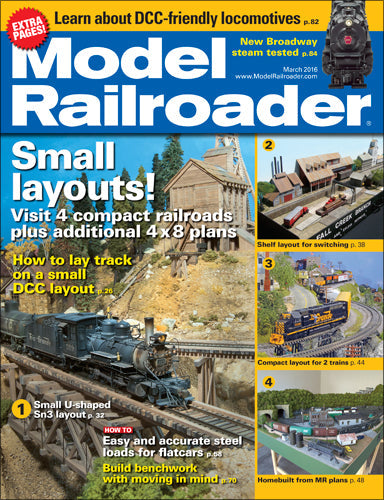Quality over quantityby Lou SassiA trip to the National Narrow Gauge Convention in St. Louis in 1990 left Pat Gerstle convinced narrow gauge was the way to go. Although he built what he calls “a decent” HO layout as a teenager, he didn’t consider himself a serious modeler until about 20 years ago. But why S scale?“What changed me was that the running qualities of the HOn3 items were just not very impressive,” Pat said of his visit to the 1990 convention. “The trains and layouts were beautiful but they just didn’t operate smoothly or reliably. “I know they’ve improved a lot since then, but that’s what I saw at the time. Then I experienced the world of Sn3 operations, and couldn’t believe how well it ran and how great the sound systems were.”How to operate a small switching layoutby Robert W. PethoudRobert Pethoud's HO scale Fall Creek Branch features three 15 x 48-inch sections. The portable switching layout attracts newcomers and veteran hobbyists alike at various shows.The American Dream in HO scaleby Judy MilfordJudy Milford's HO scale Sherman Hills layout represents an idyllic town in the northeastern United States. Designed as a display layout, the compact, simple track plan has two independent loops. Hauling Coal on the Penn Centralby Steve CampbellThe author decided to build the Model Railroader staff’s Virginian layout with one notable distinction. His version of the layout focuses on coal-hauling, but it models his favorite prototype, the Penn Central (ex-New York Central) in the 1960s and ’70s.4 track plans for 4 x 8 tablesby Steven OtteThe fact that plywood is sold in 4 x 8 foot sheets is just one reason for the popularity of 4 x 8 track plans. A free-standing, compact tabletop railroad appeals to apartment dwellers and others who don’t want to bolt a layout to the walls. It’s a manageable size that can fit in almost any spare room, stash in a corner of the basement, even lean against a wall if necessary. It’s big enough to keep an ambitious modeler occupied, but not so big as to intimidate a beginner.Model realistic stacked steel platesby M.R. SnellBanded stacks of steel plates riding on bulkhead flatcars are a common sight on today’s railroads. The plates are often covered by a layer of surface rust and dust. The flatcar usually features wood runners and stakes to hold the massive load in place. All of these elements add up to an interesting modeling project.Improvements below the benchworkby Robert StelmachThe author created an attractive and spacious appearance for his railroad room by building a unique supporting structure for the layout. The arched leg structure, made of wood and PVC pipe, was inspired by steel canopy supports on a New York central passenger platform.Kitbash a Santa Fe CF7 diesel locomotiveby Craig ChandlerThe author explains how he kitbashed an Athearn HO scale model to make a variation of an Atchison, Topeka & Santa Fe CF7 with an angled cab and two side windows.Build benchwork for a sectional layoutby Pelle SøeborgThe lesson I learned from cutting up my old layout in pieces to be sold, was no matter how careful you are, you can’t cut a layout without some damage to track and scenery. So after three permanent layouts, I wanted a sectional layout. I wanted my new layout to be movable rather than portable. There are no intentions of taking it to shows and such, but I wanted it to be easy to move if I end up selling it, or if I move and want to take the layout with me.How to scratchbuild a beam bridgeby Jim FerencThe Colorado & Southern Ry. main line crosses Boulder Creek on a two-span steel I-beam bridge. Cottonwoods and willows elegantly frame the bridge as the creek rushes below. Re-creating this eye-catching scene for my HO scale C&S Northern Division has been a longtime goal.I photographed the prototype bridge 20 years ago. Drawing a plan from these and other photos, I shortened the 60-foot prototype to fit my scale 50-foot space by leaving out a 5-foot section of each span. This was easy, as the bridge deck ties are spaced on 1-foot centers with a 5-tie repeating pattern.



